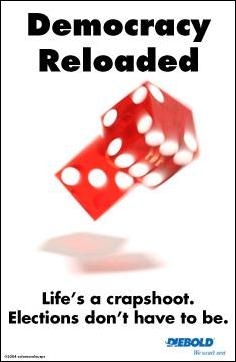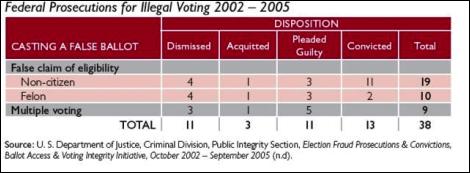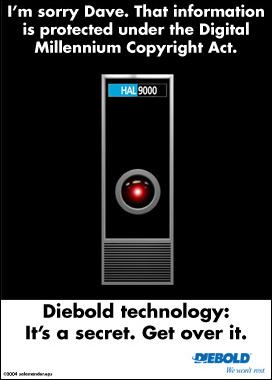The First One’s Free
…then you
pay

Diebold Variations © (with permission)
Michael Collins
“Scoop” Independent News
Washington, D.C.
Where did all these electronic voting machines come from anyway? They produce nothing but controversy. You can’t see where your vote goes. You can’t watch the votes being counted. Even if you could, it’s all done by computer. Have you ever watched a computer do anything?
Our voting machines come from a bipartisan bill produced by the Congress with strong White House support: the Help America Vote Act of 2002 (HAVA). It was going to solve the problems of Florida 2000.
What were those problems? It depends on who you ask. If it’s the White House, the bill supporters, and the media spin machine, there was a big controversy because of hanging chads. The White House and Congress were so proud of themselves that they made this solution available free to the whole country.
If you ask anyone who studied the situation, the few hundred vote count difference the chads created didn’t amount to much compared to the pre election and Election Day travesties in Florida 2000 which threw out over 150,000 votes, mostly for Gore.
First there was the exclusion of qualified voters by the Florida Secretary of State. Pre election, at least 57,000 Florida voters were taken off the voting rolls because they were supposedly “felons.” They were not. Half were minority voters, predominantly black Floridians. Black turnout in Florida was over 70%. You do the math. That’s a big Gore victory.
Second, there was the rejection of 150,000 spoiled ballots. Every federal election cycle, a few million votes are just tossed because they’re spoiled (allegedly unreadable). This happens at a much higher rate in minority precincts. A careful research study concluded that a combination of factors predicted high rates of spoiled ballots in Florida 2000. The mix was a large minority population, mostly black, in a county governed by a Republican board of supervisors. Florida’s 150,000 rejected ballots in 2000, accounted for 7.8% of the national total of 1.9 million.
So what did the White House and Congress do? They passed the Help America Vote Act of 2002 (HAVA). That was about helping those two million disenfranchised voters get their votes counted right?
Wrong! It was about solving the problems of hanging chads on punch card ballots. They must have missed the finding in the Ft. Lauderdale Sun Sentinel (1 Dec 2000) showing that the Florida chad problems could have been solved if Miami-Dade and other counties had just cleaned the tablets on which punch cards were marked.
FREE VOTING
MACHINES… here, have one, it’s
free.
When the president signed HAVA it
had a special clause that made it irresistible. The voting
equipment was free. What a deal! Congress promised and
delivered on billions of dollars for the purchase of
electronic voting machines. Free at first! Few
complained.
All the states and counties had to do was go along with the act and its main goals. The Election Assistance Commission, steward of HAVA, states the goals:
Replace punch card voting
systems
To establish the Election Assistance
Commission…
To establish minimum election
administration standards for … Federal
elections.
The initial authorization for HAVA funding was $3.8 billion dollars. $2.4 million had been disbursed just in time for the 2004 fiasco. Digital cash inducements continue but with strings attached. The Holt Bill, H.R. 811, will amend and add more than a billion dollars for new systems to help America vote..
A new bureaucracy was born – HAVA compliance. The money wasn’t really free; but you knew that. By taking the money, counties had to promise to obey new federal regulations.
These called for centralized registration databases in all the states. This expanded the opportunity to efficiently purge legitimate voters from Florida to all the states.

HAVA provided another opportunity to deny votes. It supported voter identification laws. These laws attempt to solve the patently fake problem of voter fraud (unregistered individual voters, poor & minority, lined up to vote). Average convictions and guilty pleas averaged six a year, hardly a crime wave, not even close to a justification.
So much for solving the real problems of Florida 2000.
Hidden Costs Emerge Quickly
There are some very unhappy customers in counties all across the country. It seems electronic voting is not free forever, just at the start. Once you’re hooked, there are all sorts of additional costs. A study by Suffolk County, New York summarized the problem:
"There exists a myriad of additional components which would need to be considered when addressing the cost of adopting an electronic voting system, including but not limited to software products, service rates, optional accessories (such as a voter-verified paper audit trail), training fees, ...audio preparation fees, cartage, storage, maintenance, technical support, and voter education."
Salt Lake City, for example, found out that election costs have soared under the helping hand of HAVA.
The Salt Lake City Council is ready to bite the bullet and pay three times more for its municipal election than it has in previous years. The extra costs are mainly because the new electronic voting machines require more training for poll workers at higher wages. The machines are also in short-supply, which could mean fewer polling locations… KCPW News 11 July 2007
What a bargain! You pay more and you get fewer precincts. Good thing there’s no competition in the voting business. The government would be finished.
Riverside Count, California one of the first locales to adopt touch screen electronic voting saw its elections budget soar. There were performance and security questions as recently as the 2006 elections. The San Diego Union reported on July 17 that “According to the (blue ribbon) committee's report, the county should phase out electronic voting in favor of ‘a hybrid voting system whereby able-bodied voters mark their preferences on paper ballots which are then counted by optical scanners.’”
So billions of dollars later, botched election after election, and the loss of confidence in the entire system, what do we have?

Diebold Variations © (with permission)
The
Real Costs of Helping America Vote
Computerized voting is secret. Your county election
official can’t look inside the machine or examine
the basic computer code. That’s in their contract with
Diebold, ESS, etc. Even if they could, most would lack the
expertise to understand and judge operations and security
features.
.
Verifying votes is either
impossible or faith based. The touch screen systems
fail to produce a real audit trail. When they do, all you
get is a paper receipt. This may or may not reflect the way
the touch screen counted your vote. Optical scanners, which
count voter marked paper forms, are computerized tabulators.
These have digital memory records of votes ( the real
ballots by law). We don’t get access to that. It’s
private, manufacturers only. We’re told, “Move
along.”
But the real cost of computerized voting is to the process formerly known as democracy. Since we don’t know how the machines truly operate and there are no real ballots to recount, there’s no way elected officials can actually demonstrate that they were elected. There have been many questionable elections since 2000. The quick response by the winner has been sore loser or spoiled sport. That’s not only a dishonest response; it’s had its day with the public. Americans have very negative attitudes toward electronic voting.
Electronic voting has stripped elected officials of the ability verify their own elections (even if they wanted to). It failed to address the real problems of Florida 2000 and the nation
Were all these losses worth a few less than reliable, highly corruptible voting machines from third or fourth tiered technology companies?
If they can’t show that they were elected, do we have to obey?
Permission to reprint in part or in whole provided with a link to this article in “Scoop” and attribution of authorship.


 Binoy Kampmark: Blinken Atrocious In A Dangerous World
Binoy Kampmark: Blinken Atrocious In A Dangerous World Jim Mikoz: Look Out Rocks … Oops Too Late
Jim Mikoz: Look Out Rocks … Oops Too Late Peter Dunne: Dunne’s Weekly - National And Labour Combine To Shut Out Greens
Peter Dunne: Dunne’s Weekly - National And Labour Combine To Shut Out Greens Ramzy Baroud: Voting Against Genocide - How Gaza Defeated The Democratic Establishment
Ramzy Baroud: Voting Against Genocide - How Gaza Defeated The Democratic Establishment  Alastair Thompson: Google's Support For Democracy And Media In NZ | Part 2
Alastair Thompson: Google's Support For Democracy And Media In NZ | Part 2 Eugene Doyle: BBC Goes Full Goebbels In Support Of Israeli Soccer Hooligans
Eugene Doyle: BBC Goes Full Goebbels In Support Of Israeli Soccer Hooligans